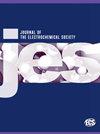电位和硼酸对 Pt1-xCox 合金电沉积和磁性能的影响
IF 3.3
4区 工程技术
Q2 ELECTROCHEMISTRY
引用次数: 0
摘要
研究了电位和 B(OH)3 的存在对 Pt1-xCox 合金在 Ru 基底上从氯化物水溶液中电沉积的影响。在相对于 SCE 的还原电位高于 -0.65 V 时沉积的薄膜为六方紧密堆积,钴含量超过 90%(摩尔基);而在相对于 SCE 的氧化电位高于 -0.65 V 时沉积的薄膜为面中心立方体,并且随着电位的升高,钴含量呈单调下降趋势。结构变化与成分-电位关系中明显的膝状特征以及与钴沉积有关的突出窄伏安峰相吻合,这可能与 hcp 相的成核和生长有关。在电位接近 -0.65 V 时,B(OH)3 的存在会使库仑效率和沉积速率急剧下降,并几乎完全抑制了伏安特性。这可能与 B(OH)3 衍生的质子还原以及吸附的 B(OH)3 或 B(OH)3 衍生物种对金属沉积的抑制作用有关。B(OH)3 的存在对在氧化性比 -0.55 V 更强的电位下沉积的薄膜(即钴含量低于 40% 的薄膜)的磁性行为影响较弱,但对在还原性更强的电位下沉积的薄膜的最大磁化率普遍较小,尤其是在 -0.65 V 下沉积的薄膜的磁化率更低。本文章由计算机程序翻译,如有差异,请以英文原文为准。
Influence of Potential and the Presence of Boric Acid on Pt1-xCox Alloy Electrodeposition and Magnetic Properties
The effects of potential and the presence of B(OH)3 on Pt1-xCox alloy electrodeposition from aqueous chloride-based solutions on Ru substrates was investigated. Films deposited at potentials more reducing than −0.65 V vs SCE were hexagonal close packed and greater than 90% Co (mole basis), and films deposited at potentials more oxidizing than −0.65 V were face centered cubic and showed a monotonic decrease in cobalt content as the potential increased. The composition and structure-potential dependences were not strongly affected by the presence of B(OH)3. Structural change coincided with a distinct knee-like feature in the composition-potential relationship, along with a prominent narrow voltammetric peak associated with Co deposition, possibly related to nucleation and growth of the hcp phase. The presence of B(OH)3 produced a sharp minimum in both Coulombic efficiency and deposition rate at potentials near −0.65 V and almost entirely suppressed the voltammetric feature. This may be associated with a combination of B(OH)3-derived proton reduction and inhibition of metal deposition by adsorbed B(OH)3 or B(OH)3-derived species. The presence of B(OH)3 affected the magnetic behavior of films deposited at potentials more oxidizing than −0.55 V (i.e., those with compositions less than about 40% Co) only weakly, but resulted in generally smaller maximum magnetizations for films deposited at more reducing potentials, and notably a much lower magnetization for films deposited at −0.65 V.
求助全文
通过发布文献求助,成功后即可免费获取论文全文。
去求助
来源期刊
CiteScore
7.20
自引率
12.80%
发文量
1369
审稿时长
1.5 months
期刊介绍:
The Journal of The Electrochemical Society (JES) is the leader in the field of solid-state and electrochemical science and technology. This peer-reviewed journal publishes an average of 450 pages of 70 articles each month. Articles are posted online, with a monthly paper edition following electronic publication. The ECS membership benefits package includes access to the electronic edition of this journal.

 求助内容:
求助内容: 应助结果提醒方式:
应助结果提醒方式:


